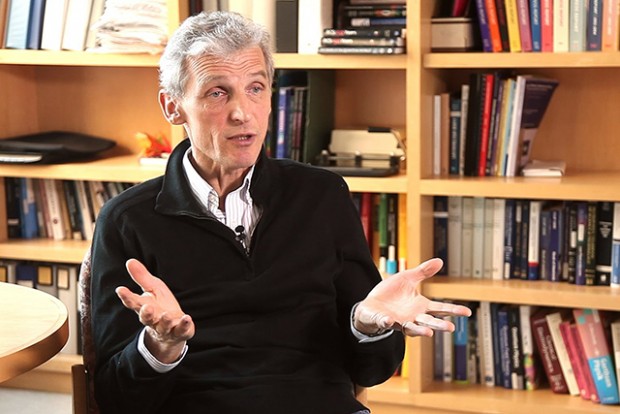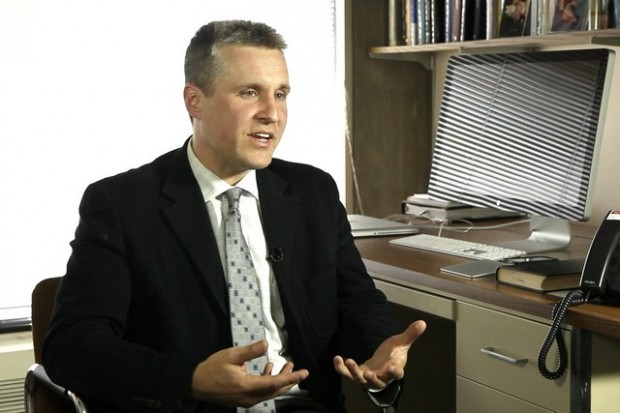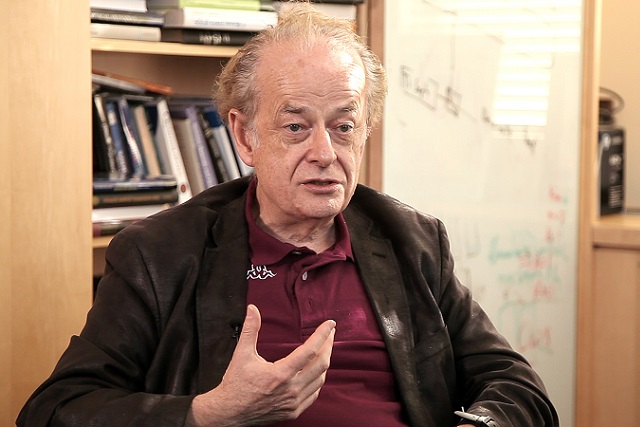Induced-Charge Electro-Osmosis
Martin Z. Bazant on elecroosmotic flows, Janus patricles, and electrokinetic phenomena
videos | August 21, 2015
What are the properties of Janus particles? How do ions behave in an electric field? What are the most interesting features of electrokinetic phenomena? These and other questions are answered by Professor of Chemical Engineering and Applied Mathematics at Massachusetts Institute of Technology Martin Z. Bazant.
A field of electrokinetic phenomena. This is the motion of particles, charges and fluids in response to an electric field. An area which has rapidly advanced in the last 10 years is so-called induced-charge electrokinetic phenomena, the most basic being induced-charged electro-osmosis. Electro-osmosis is the motion of an electrolyte or a charge-containing or iron-containing liquid in response to an electric field.
So think of, for example, sodium chloride dissolved in water – you have positive and negative ions, sodium and chloride. And typically the electrolyte, the liquid is neutral, so there is roughly equal amounts of positive and negative. But near a boundary there’s always some surface charge or some sort of chemical equilibrium that gets established which always leads to some surface charge, and then as a result there is an imbalance of positive and negative, for example, sodium and chloride ions in the liquid near the surface.
A relative phenomenon is electrophoresis. So we just talked about the flow over a surface which is charged in electrolyte in responses to a field. Now imagine that surface is part of a particle, a solid particle that is charged on its surface sitting in electrolyte. Now when I apply a field, it generates these flows around itself kind of like a flowing skin on the surface, and then – essentially you could say it is Newton’s third law – you start moving by an equal and opposite reaction in the direction. So essentially a charged particle in electrolyte moves by so-called electrophoresis. And it is essentially a swimming motion: it is like the particle, when you’re applying the field, is sort of pushing the fluid behind it and hence is moving forward. And that pushing of the fluid is a relative motion – the fluid relative to the solid – caused by the electric field acting on those charges in the surface double layer that I mentioned.
Now that phenomenon of electrophoresis of colloidal particles, in fact, was in the news not too long ago, because we were celebrating the 200th anniversary of the discovery of electrophoresis in the earliest reported experiments on clay particles in electric fields by Royce in 1808. So we’ve just reached the 200th anniversary, so it’s a phenomenon that has been observed for a long time. It took about a 100 years until the work of Helmholtz, and especially Smolcowski around 1905-1908 for there to be a theoretical description of electrophoresis. So this picture I just gave you – of charges near the surface causing a flow around the particle which then makes the particle move – it took about a 100 years to even begin to understand that phenomenon theoretically.
So you can imagine it’s a relatively complex phenomenon. Then the field progressed for essentially the next century, the last century by really carefully studying those colloidal phenomena or also electroosmotic flows in porous media as well, and I would say that overall still there was one lingering assumption in almost every study which was that the surface charge was assumed to be a constant. So the problem is already pretty complicated. If you say, “I want to understand the fluid flow of a charged liquid in response to a field, I’ve got a complicated geometry, the particles are even going to move… If I, on top of that, say the surface charge is changing, it becomes really, really hard. And so that is maybe one of the reasons that people didn’t consider that.
Also for many materials such as the clay particles sitting in solution the surface charge is roughly constant. It is affected by adsorption, desorption valance or, or for example, if you change the pH, you might change the surface charge. But that’s maybe a more gradual effect, and if you just want to understand the motion of the particle, you can as a first approximation forget about it. Now when you have a constant surface charge, you’ve necessarily a regime of linear response. Well, if the field is not too large, let me qualify slightly. But if for a typical applied field, if you have a constant surface charge, then basically the field acts on the charge in the double layer, gets the fluid to move, and the amount of motion is proportional to the amount of field – so it is a linear response.
There has been recent work, in the last 10 years especially, in understanding non-linear electrokinetic phenomenon.
This is a major area of my own research. In fact, I had the opportunity to discover – for myself anyway – an example of such a phenomenon about ten years ago which we now call induced-charge electro-osmosis. And that is really the fundamental problem of what happens when you apply electric field around a surface or a particle which is polarizable, so the surface charges response the field, and in particular is so-called ideally polarizable meaning that is no chemical reaction which is changing the surface charge in space and time in some complex way, but rather is the approximation of a constant potential instead of a consonant charge.
The simplest limit of that is just a pure metallic particle with no reaction. So we take, let’s say, a metal surface or a metal particle. Let’s say, initially the total charge and even the surface charge is roughly zero. But when I apply the field, I get a charge separation, so there’s an induced dipole on the object that is polarizable. And so what happens is I charge the double layer on one side of the particle positively and the other side negatively. And then the field acts on the induced charge to drive a flow. And so because there is a dipolar charge distribution and a field which is in one direction, you can basically see a flow on one side that is going towards the particle, but on the other side, because the charge is opposite, it is actually coming back the other way. So you can generate this kind of quadropolar flow profile around a particle, which we call induced electroosmotic flow.
The interesting thing about this phenomenon, which illustrates the non-linearity, is that is if you change the sign of the field, you change the sign of every induced charge and you get the same flow. In other words, it is something which depends on e2 instead of e, where e is the field amplitude.
One application of that is that this flow can survive even in an altering electric field whose time average is zero. If I have just linear phenomenon, then if my forcing averages to zero in time – think of an AC electric field, alterning current – then the particle moves back and forth, but really nothing happens on the average. But this non-linear phenomena become important in AC forcing, because they rectify the forcing. No matter which way the field is going, you get the same flow. So you can drive a steady flow around an object, or around a surface in an AC field, provided the field is not of too high frequency. Of course, at too high frequencies there’s no time for this polarization process, and so this non-linear dynamics kicks in, and you are not able to see the flow. So at a high frequency you would lose this effect.
So basically I just wrote a theoretical work on this, initially with Todd Squares, my co-author, and just as we were getting ready to publish it and, in fact, though the review process, we learned that there was some work in Soviet Union in the 1980’s by Vladimir Mirzovkin and Andrei Diukin which had actually described and even done experiments on this very phenomenon – there were some beautiful pictures published of some flows around metal particles in electric fields which were of the type that we had described.
Now one thing about the new context in the last 10 years is that when Todd and I were first working on that, we were not really thinking of colloids. The original motivation of the Soviet Union was if you have the particles which are metallic or even dielectric and they have these non-linear flows around it, it causes interactions between the particles. So it will affect this aggregation behavior dynamics of a colloid. It’s really in some sense the same problem as Royce was studying 200 years ago, except now it’s getting just a little bit more detailed.
What Todd and I were interested in was how do you apply this to generate motion in microfluidic devices. So instead of thinking about how the particles get to move, think about the flows themsevles as of being of interest. And so work that we did and many other people have worked on last ten years is how do you design geometries of polarizable particle, for example, metal electrode arrays in microchanells in order to get desired flows from mixing and pumping on demand. And the ability to control it electrically is very important, because if you miniaturize the device, it’s kind of difficult to apply a pressure, for example, to get a flow. It’s easier to press a button and get a field going between some microelectrodes to control particle motion or fluid flow. And so that’s the general field of induced-charge electroconnections for microfluidics.
I would say another interesting part of that work is also looking at broken symmetries. The classical theory of colloids always starts with a perfect isotropic sphere. It’s the simplest problem, you can actually make progress analytically. But what we looked at and what has become an important topic of research is the very complex set of phenomena that can arise when you have broken symmetry. So imagine a particle, so called Janus particle particle, a two-faced particle which is half-metal, half-insulator. For example, like a latex particle covered with gold on a half of it. We can make such particles now. They have very interesting behavior, for example, in an applied electric field – we predicted it and it was later observed – that particle actually moves sideways in an AC field rather than forward or backwards.
You can even design objects that will spin in AC fields.
And so it just gives you the sense of a very complex and non-linear behavior that can occur when you allow the surface charge to be coupled to the flow.
I would say to me the most interesting part scientifically is not just the applications and the new phenomena that can be observed and used for engineering, but it’s really that this set of problems has led us to a sort of another frontier in theoretical electrochemistry. Electric chemical systems cannot sustain very high voltage for very long. Because if you just have a steady voltage applied, then, for example, if you have more than 1 volt in water, you start to bubble hydrogen and oxygen, you start to decompose the solvent. These unwanted reactions may start to occur as you’re not able to sustain that voltage. But if you have an AC voltage though, you can be at a high voltage and those reactions’ time average is zero, they don’t really happen. So you’re able to access a regime of high transient voltages.
This class of induced charge electrokinetic phenomena has to do with large transient voltages in very small geometries, and so it allows you to study electrolytes under the conditions that have never been looked at before. If you think of that double layer now – we do experiments now where we might be applying 5 volts at a 100 kilohertz to a microelectrode. So if think that they’re either being squashed on and off at a 100 kilohertz, that’s a 100 000 times per second you’re changing the polarity, at a voltage which is 5 times the electric chemical stability of the system, and yet you’re not seeing those reactions and you’re getting some complex time average flows. We’ve found that even our best theories are not able to describe everything that we see. So it is really a frontier of theoretical science to understand the non-linear dynamics of electrolytes in these large transient voltages. And I think there’ll be lots more progress in that field in the coming years.































